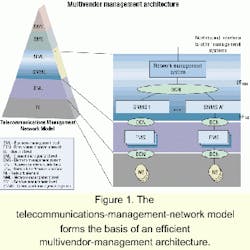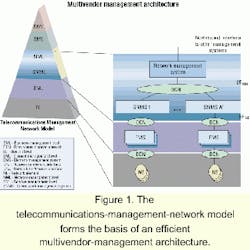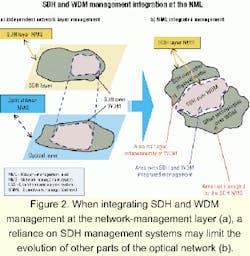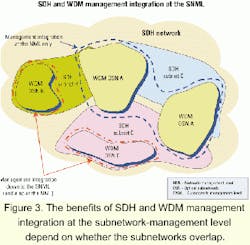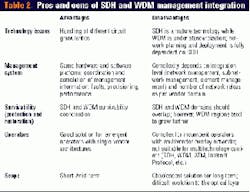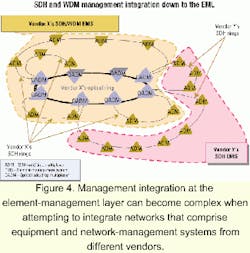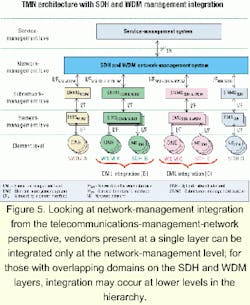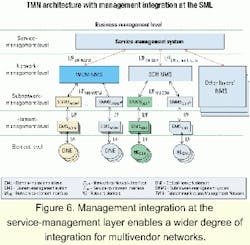Management analysis on SDH and WDM networks
To integrate or not to integrate? That is the question for network operators today.
BY ANTONIO FONTALBA
Today, most transport networks are based on SDH or SONET technology. However, DWDM, which started some years ago, may become an important technology not only at the network core, but also at the network access.
The importance of SDH/SONET derives from the nature of the technology itself, which has a high level of standardization (for bandwidth, flexibility, crossconnections, etc.), and from the variety of good management solutions now available from many vendors. WDM's increasing popularity develops from its provision of improved bandwidth capacity, bit-rate transparency, client transparency, and flexibility in reconfiguration and crossconnection, among other benefits. However, there is still a lot of hard work to do in the area of management.
Optical-network management architectures that accommodate WDM are under study today. Integrating WDM and SDH is a good solution for some operators, but is not a trivial exercise for those who plan to establish a multivendor network. As an analysis of the advantages and disadvantages of developing either an independent or an integrated management architecture for both SDH and WDM technologies illustrates, no solution is the best one. For some operators, integration is the solution to their problems, while for others, having separate management architectures would be compatible with the evolution of their networks and management systems. However, a new type of integration at an upper level, featuring a sort of interdomain management system, may prove beneficial to a wide range of operators.
When operators or carriers decide to deploy a telecommunications network, they can buy the necessary equipment from either one vendor or a number of them. Building a network with more than one supplier has a number of advantages and disadvantages that have to be fully analyzed before making such a decision. In some cases, a carrier that decides to establish a new technology layer may first try to deploy the network with a single vendor and then expand it with another.Carriers who take a multivendor approach are looking for a better price and the advantage of implementing the latest technological advances and best features. However, a single-vendor approach would guarantee compatibility among network elements throughout different network releases and the ability to provide seamless network solutions with an end-to-end management architecture. Table 1 summarizes the pros and cons of multivendor versus single-vendor approaches.
Some carriers have overlay network layers (i.e., ATM, SDH, WDM, etc.), with a multivendor approach on some of them. In such cases, solving end-to-end management (including provisioning, alarm handling, performance monitoring, network survivability, and other functions) becomes very complex and costly. This situation is much more difficult to cope with when technologies have differences in both maturity and degree of deployment, as in the case of SDH and WDM networks.Figure 1 shows the distribution of management systems according to the telecommunications-management-network (TMN) model. Single-vendor-management architectures are provided by a large number of companies for both SDH and WDM technologies. In the SDH case, since this technology is very well standardized, most TMN management functions are fully covered: configuration, fault management, performance, security, and accounting management.
On the other hand, WDM technology is at a very early state, and WDM configuration management is very limited. Today, the main physical WDM topologies are long-haul and metropolitan point-to-point routes and metropolitan rings. Optical meshes are constrained by the functionality and high costs of optical crossconnects. The flexibility to set up optical channels/circuits is subject to the state of the art of WDM technology, and reconfiguration of the network has to be carried out manually in most cases.Alarm handling, which is the main concern of network operators, has been provided since the very beginning of WDM deployment. Basically, inherent monitoring reports faults (such as fiber outages, network elements/subsystems failures, etc.) and optical-service degradation, which is reported by the optical supervisory channel.
Performance monitoring is efficient with synchronous signals (by analyzing the SDH B1 octet), but it is not so with the transparent ones (such as Gigabit Ethernet, Ficon, and Fibre Channel) because quality of service is assessed from optical parameters such as signal power, noise, etc.
Network operators need to optimize their costs to differentiate themselves from the competition. Having their network-management architecture based upon multiple operation and support systems (OSSs) is expensive. For this reason, the integration of SDH and WDM OSSs may become a good choice for transmission management. Other advantages of network-management integration are better alarm handling and correlation, global survivability coordination and correlation, improved provisioning, and more.
Figure 2 illustrates a management integration approach from the network-management-layer (NML) viewpoint. Given the SDH and WDM network layers, only a part of the SDH network runs over WDM. The rest of the SDH network will use other media, such as optical fiber, electrical media, or radio communications.
On the other hand, WDM not only supports SDH, but it is also a transport layer for other protocols such as ATM, Multiprotocol Label Switching (MPLS), and Gigabit Ethernet. Although SDH is still the main client of WDM networks, other protocols will increase the use of the optical network.Management integration at the NML, performed from the SDH network-management system, has the risk of leaving out other technologies that also use (or may use in the future) WDM layer services, which means that the evolution of the optical network is subject to that of SDH. Technologically speaking, it is dangerous to limit one new technology (which is still undergoing standardization) by a mature and well-standardized one. In this case, the costs savings of integration are not significant enough.
Nevertheless, some operators will find an opportunity in management integration. Small and niche operators can reduce costs through an integrated solution because they can manage their entire network from a single OSS. This can also be interesting for operators who have the same vendor in both the SDH and WDM networks. On the other hand, it becomes a problem for carriers with different vendors in each layer and a wide circuit-service offering that uses protocols other than SDH.SDH and WDM management integration can be implemented at other TMN levels, such as the subnetwork-management level (SNML) and element-management level (EML). Figure 3 presents a WDM network that services an SDH network, where network-management-level (NML) integration is assumed. In fact, several important carriers have SDH and WDM networks consisting of multivendor domains, and vendors may be present on one or two network layers.
In general, the same vendor's domains on every layer do not overlap in most cases. For instance, vendor A in Figure 3 has an optical subnetwork servicing different SDH domains (from SDH vendors B, C, and D). In this multivendor network, integrating at the SNML is difficult and a question arises: Which vendor would you choose to integrate with? For a nonoverlapping network deployment, integrating at the NML only is probably the wiser solution. Moreover, this problem can be harder to control if new OSS network releases are considered. On the other hand, when SDH and WDM subnetworks overlap (for some domains of vendors B and C), management integration at the SNML can be a good choice.Figure 5 presents the network-management architecture that results from integration at different TMN levels. Vendors present at a single layer (either SDH or WDM) can only be integrated at the NML, and for those with overlapping domains on the SDH and WDM layers, integration can be realized at lower management levels.
Table 2 summarizes the advantages and disadvantages of SDH and WDM management integration.
To overcome the disadvantages of the management integration of two different technologies such as SDH and WDM, a different approach can be taken. Integration at the service-management level (SML) can be applied to both classical (SDH, SONET, ATM) and emergent (WDM, MPLS, etc.) networking technologies. The resulting TMN architecture is shown in Figure 6.
From the SML, any upper OSS (from the operator or from a client) can take a complete view of the network and the services provided, independently of the number of network layers, vendors, or technological domains. According to the TMN model, this new architecture is scalable. That means that any network layer's network-management system (NMS) can be integrated at the SML so long as both an NMS and an interface are provided.
The SML approach provides network operators with a competitive advantage for network management in a multitechnological environment, thanks to the global view of the network: network planning and deployment tasks, resource optimization, circuit provisioning, global alarm handling (correlation and location), global performance monitoring with service-level agreement checking, optimal survivability deployment, etc.Alarm handling can be realized in a centralized manner with every NMS reporting faults to the service-management system (SMS). Since the SMS has a global knowledge of network entities, it can perform correlation of alarm information and detect the root and location of problems.
Network survivability, protection, and restoration can be optimized to enable the allotment of the necessary resources for the desired degree of network availability. Resilience distribution across the network layers and the compatibility of different technology survivability mechanisms is a considerable task that can be achieved from the SMS with a global understanding of the entire network. To attain this goal, a global survivability plan is needed and the SMS would be responsible for implementing it by means of the NMS.
Customers can be provided with an interface from their OSS to the SMS. Verification of SLA compliance and alarm reporting of leased circuits is something that clients seek from a network operator, and this management architecture makes it possible for operators to use any underlying technology necessary to meet customer requirements. Table 3 summarizes the advantages and disadvantages of management integration at the SML.
When deciding to deploy their network-management architectures, which solutions operators adopt strongly depends on the number of network layers (SDH, WDM, etc.) and network-deployment strategies, either single-vendor or multivendor.
SDH (or SONET) and WDM management integration has several advantages, especially for emergent operators relying on a single-vendor network (Table 2). Integration at the service-management level would offer incumbent operators a good opportunity to implement a global network management from a single OSS (see Table 3).
WDM optical networks should evolve in both physical and management architectures. Management should be compatible with a multivendor network deployment and should keep the doors to optical evolution wide open. Integration at an upper level, such as the SML, may be a good choice to allow for the future development of WDM networks.
Apart from the TMN viewpoint of the management architecture, a new approach is also under study today: network element communication through signaling. If node signaling could solve important management problems (provisioning, fault recovery, etc.), maybe the TMN model would have to redefine its scope. Nevertheless, the management considerations made in this paper are fully applicable today.
Antonio Fontalba is a consulting engineer based in Madrid. He can be reached at [email protected].
